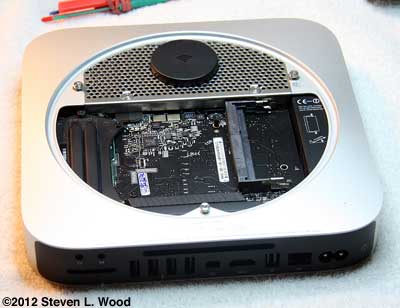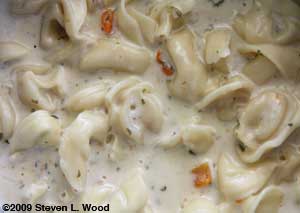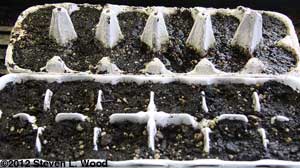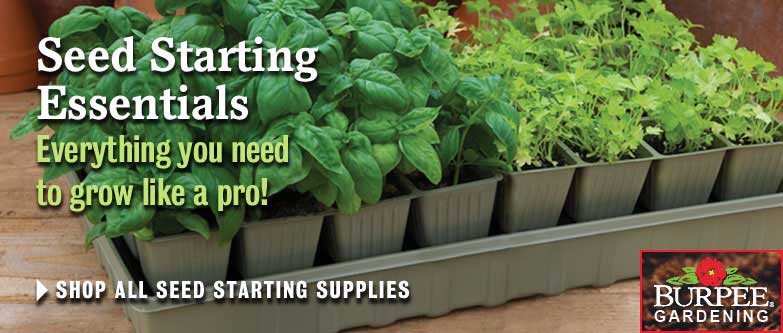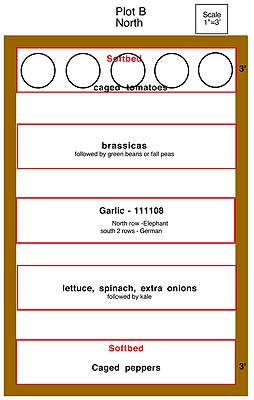One of the Joys of Maturity |
|
| Affiliated Advertisers |
Clicking through one of our banner ads or some of our text links and making a purchase will produce a small commission for us from the sale. The Old Guy's Garden Record
While I hate to waste good weather days, I took it a bit easier today, as I had an early morning appointment with the laser surgeon. While it's great that cancers and pre-cancers can be easily lasered off, it's also a reminder that as we age, taking adequate precautions when working in the sun is essential.
One of the joys of living in the country is being able to let our dogs run free. They follow us wherever we go on the property and try to accompany us on walks and bike rides. Over the seventeen years we've lived at this location, we've had lots of dogs. They've all lived pretty good lives. Sadly, folks don't seem to have any feelings about dumping the previous family pet in the country to fend for itself.
At this time last year, much of the nation was reeling from a major winter storm. Our power was out for a couple of days, and we huddled around our kerosene heaters to stay warm. Today, I worked outside with a light sweatshirt over my flannel shirt...and worked up quite a sweat. Our warm and dry weather broke overnight with a cool, but needed rain. Daily highs are supposed to be down 10-20o over the next week with some freezing temperatures in the early morning hours. The contrast in weather over what we had a year ago is amazing. At this time last February, we were recovering from a winter storm that had shut off our power for a couple of days and pretty well immobilized our area, if not a good bit of the nation. So even with the cooler temperatures, we're doing pretty well for early February.
Compost
The second pile had begun to look like a garbage heap a few weeks ago, as I kept adding kitchen scraps to it with no covering. The partially digested material from the first pile has now covered the sprouting onions, bad potatoes, coffee grounds, and vegetable peelings that had been previously exposed. We'd never get away with such a mess in the city, but living in the country with our nearest neighbors far downwind, I can cheat on care of the pile at times. The second pile also needs to be turned, but with the rain and cooling temperatures, that will have to wait for better weather. Mixing a pile regularly and adding a bit of lime and fertilizer helps it break down a bit more quickly. During the winter, however, things are usually just too cold to permit much decomposition, but having the pile ready when warm weather arrives saves having to mix the pile then when other garden chores mount. The smaller, third compost pile at the back of the photo is one that contains asparagus, broccoli, and kale stalks, along with some other slow-to-digest materials such as leaves from the yard and grounds. Without a chipper/shredder
Other Stuff
I usually try to prepare a bed for spring peas sometime in the late fall. This year that meant just getting the last of the lettuce out of the way, as I'd thoroughly tilled the area before putting in the late lettuce. The now removed mulch held back most weeds, although I did pull a few stray weeds yesterday. Sometime early next month when the soil is at least partially thawed, I'll just scatter my early pea seed in a 6" wide row down the center of the bed. Then I'll poke the seeds into the cold soil one at a time. It's a little hard on the fingers, but is an easy way to get ones peas planted really early. The pea seed will just sit until conditions are suitable for it to germinate. Note that I don't use this method for some pea varieties such as Eclipse, and to a lesser extent, Encore, that require fairly warm soil to germinate. Since we just used up the last of our peas frozen from last year's garden (along with the last of our sweet corn and our carrots Tuesday, February 7, 2012 - Quinte Tomato Seed I traded several emails with Stuart Pollack last October about early tomato varieties. In the course of the discussion, I shared that I'd lost my start of the Quinte Easy Peel variety, one developed at the Smithfield Experimental Farm in Canada that also developed and released my favorite tomato variety, Moira. Stuart directed me to the USDA Agricultural Research Service Germplasm Resources Information Network (How's that for a mouthful!), as he'd done a search and found they had "material...available for distribution" for "educational, agricultural research or breeding purposes." While I wasn't sure I'd meet their criteria for distribution, I went ahead and located their Quinte page and requested a seed sample. I quickly received a confirmation of my request. Then I forgot all about it until yesterday.
There's not a lot of good information available about the Quinte variety. The Canadian Tomato Cultivars page on the Seeds of Diversity site has a listing of the varieties developed at the Agriculture Canada Smithfield Experimental Farm. They include: Trent (1967); Trimson (1972); Moira (1972); Quinte (1975); Earlirouge (1977); Earlibright (1980); Bellestar (Bellstar) (1981); and Smithbright (1993). The Long Island Seed Project's Tomato Descriptive Information page carries the following description, although I think I got my seed in the 70s from Stokes Seeds:
Their description of the Moira variety adds a bit more information about the line and its breeding:
And members' comment pages for both Quinte and Moira on Seeds of Diversity confirmed something I'd noticed about Moiras. Although both are usually listed as determinates, they seem to tend towards being "somewhat indeterminate" at times. Like many gardeners, I hate it when a variety I like slips from commercial seed catalogs. If the variety is a hybrid, one is just out of luck. But fortunately, folks have been saving and sharing open pollinated varieties for years, whether through Seed Savers Exchange, Seeds of Diversity, handing them down through generations, or one of the government seed banks (both Canada and the U.S. have them). With interest in heirloom varieties of vegetables on the rise, we're seeing more and more commercial operations devoted to selling heirlooms only, and some of the mainline commercial seed houses are carrying far more heirlooms than they once did. While the Moira and Quinte tomato varieties aren't available in the U.S. from any commercial vendors (that I know of), Canadian gardeners are in luck. Upper Canada Seeds carries both varieties! Thursday, February 9, 2012 - Seed Savers Exchange Annual Yearbook
We have the same three listings we've had for several years: Moira tomatoes, Earliest Red Sweet peppers, and Japanese Long Pickling cucumbers. While I plan to continue to offer these varieties in the future, I hope to also offer Paprika Supreme peppers and possibly Quinte tomatoes next year. Somehow, I didn't get our listings properly updated, so they all show as "limited quantities." I generally get less than five requests for seeds via SSE per year, so my oversight in making my listing "has" (which means any member can order) really isn't a biggie. Interesting Planting Technique In an email exchange with fellow senior gardener, Joe Bonner of Germantown, Tennessee, I learned about a seed starting technique that sounds interesting. Joe plans to try something he saw on Wintersown.org that involves using recyclable materials to start seeds outdoors. He plans to split open plastic, gallon milk jugs, add soil and seed, and reseal them with duct tape. The idea of the technique is to set the containers outside, depending on the seed to recognize proper germinating conditions. While I'm pretty satisfied with our current seed starting setup, I can see how the method above might be really useful in starting seeds that require stratification and/or scarification. Asparagus seed, daffodils, and almost all conifer tree seeds need to either go through some freeze and thaw periods to germinate well. Planting them in inexpensive containers and then setting them out in an unheated environment (porch, garage, ??) might give them the conditions they need to germinate.
I've not been working very hard at gardening this week, as it's cold outside, and I've been otherwise occupied inside. After my main computer toasted its motherboard in December, I picked up a good replacement unit for nearly the cost of just a used motherboard! But even then, I was still working with a very old computer.
While my office is a disaster of boxes, tools, software, cables, and so on, I've already moved one of the three towers off my computer table. My old HP Pavilion that I rarely used was obsoleted by the Mini's ability to run Windows 7 under Parallels 7 for Mac! The original plan was to get all the towers out of the office, but I can already tell that I'll still need the seven-year-old G5 tower for a few tasks here and there for a while. But even just cutting down to one very large tower computer plus the tiny Mac Mini and a couple of external drives will free up a lot of space and also ease the cable tangle of cords running to and from the KVM box I don't have anything against vintage computers. Years ago, I wrote a column about using vintage computers in the classroom for the Low End Mac site. But things had gotten to the point that there were very few new software programs that I could run on any of my computers, and I still need to test and review software from time to time for my other web site, Educators' News. It's tough to review stuff when the software or the web site won't even load onto your computer! Once the Mac Mini is completely settled in, my backup dual 1.8 GHz G5 tower will be surplus and sold. I'm not quite sure what I want to do with our eleven-year-old G4 QuickSilver Mac (shown in the corner of the photo above). It still boots to Classic OS 9 or Mac OS X (well, Tiger or Leopard). It's a noisy beast, but I like it. It may find a place on a table in our computer workshop along with my 1998 G3 tower and a still internet capable, twenty-one year old Mac IIfx!
Tuesday, February 14, 2012 - Valentine's Day
I gave up waiting on seed to germinate in our second tray of onions today and poked in a bit more seed in each of the rows. I also pulled the onion tray off the heat mat to make way for a new seeding of geraniums later this week.
Why 3" pots? I goofed a couple of years ago and ordered a bunch of them that I really didn't need!
Perched on coffee "cans" next to the petunias are two gloxinias. One of them has a couple of nice, small, purple blooms and the other has lots of blooms on it. (The plant label says "purple," so we may have a whole lot of purple blooms soon.) Moving downstairs under our plant lights, we have just two more gloxinias in bloom, with another maturing seed pods from some hand pollinating I did last month. We have lots and lots of baby gloxinias, several three and four-year-old plants that are just putting on leaves after several months of dormancy, a number of others winding down towards dormancy, and a whole bunch dormant in a dark area of the plant room. The hand pollinated pods are on an Empress gloxinia, but the pollen came from a purple Double Brocade. I've read that the hybrid Double Brocades are sterile, but it appears their pollen got the job done on the Empress. Of course, I could have shaken some pollen off the Empress onto its own stigma. It will be fun to see if the seed is viable, and if it is, what colors and types of blooms we get. A Nice Chat and a Bit of a Rant I wrote last month about a test planting I did of geranium seed from Swallowtail Garden Seeds. It was my first time ordering from them, and I was disappointed that the seed only germinated at 32% under what I felt were ideal conditions. I finally called Swallowtail at the end of January and requested a full refund, rather than the offered full seed replacement. I really didn't want any more bad seed! But I noticed today that no refund had been posted to my credit card. I also remembered that I'd written Swallowtail's owners, Lynn and Don McCulley, about the poor seed, including control numbers from the packets in case they wanted to further investigate. The letter did no more good than the phone call to customer service. Not being able to get the situation resolved via phone support or a snail mail letter, I posted an incredibly negative review of my experience on their review page on Dave's Garden Watchdog. I then emailed Swallowtail a protest of the non-existent refund, including a cut and past from the posting that said, "Bad seed. Snotty customer service. No refund. I think I'm done with Swallowtail Garden Seeds." They usually respond to negative reviews there. Sure enough, within a few hours, I received a call from Lynn McCulley, informing me the refund had been posted and apologizing for the bad experience with their seed and customer service. We talked for fifteen minutes or so, and I was impressed with her personal attention to my complaint. But Lynn never did say they were going to check their seed. It would be great if in a few days, I received an email from Lynn with the results of a germination test they conducted with the batches of seed I questioned. It might also be cool if pigs had wings, and Annie and I won the lottery. All have about the same chance of happening. Getting seed that supposedly germinated at 80-90% in tests, only to have it effectively fail for the user, is becoming an increasing problem for home gardeners. While Lynn stated that Swallowtail does test some of the seed they sell, it's probably impractical to impossible for them or any other vendor to test every batch of seed from every variety of flower and vegetable they sell. They rely on the germination numbers from their suppliers, and then simply make almost automatic refunds to the few folks who take the time to file a claim for small quantities of bad seed. But there seems to be something very, very wrong with the industry's current germination ratings. The Valentine Graphic
Settling In
The "new box" is exceedingly quiet compared to my old G5, that when under a load sounded like a small jet turbine. And my office, while still not tidy, isn't a cluttered mess anymore. I'm keeping the G5 tower in the office, but retired an HP Pavilion and a G4 Quicksilver Mac, leaving lots more working space. The seven-year-old G5 functions as a sort of security blanket for times when I must run a piece of old software that won't go on Snow Leopard (Mac OS X 10.6.8) and also fills my gaming addiction to a really old Mac classic game, Risk II. An even better security blanket, however, is the G-Raid 2TB external hard drive So hopefully, we're set on computers for another seven years. Wednesday, February 15, 2012 - A Few More Geraniums
A packet of Thompson & Morgan's World's Top Six geranium mix coming in the mail today got me started. The packet contains at least five seeds of six different varieties of geraniums in individual subpackets. And when I started out, I showed great restraint in planting only two seeds of each variety in the mix. But I also had a couple of new packets of 10 seeds each from Twilley Seeds. I went ahead and planted all of the Orbit Mix and Maverick Red from those packets. And then there was part of a packet of Maverick mixed I picked up from Stokes Seeds last year. Since the seed was getting old, I decided to just plant all of it. It turned out that there were over twenty seeds left! And yes, if you're keeping count, that's a little over 50 potential geranium plants! I used all the peat pellets I had on hand for the geraniums along with three 3" square plastic pots. To organize the planting a bit, I put the Thompson & Morgan seed in one egg carton, the Orbit mix in another and the Maverick Red and Maverick mix scattered around the rest of the tray. The tray went on our heat mat with its thermostat set at 78o F. Of course, the heat mat is under our plant lights, and geraniums require darkness for germination. So...even though I had been careful to cover each seed, I also triple-folded a large, black, plastic trash bag loosely over the humidome covering the tray to hold out light.
Something I forgot to mention last month, or at least didn't illustrate, is that when one uses egg cartons for starting seeds, you do need to punch a drainage hole in the bottom of each cell. A sharpened pencil is my tool of choice for the job. The top of the egg carton goes under the egg cells and serves as a drip pan...if you're using styrofoam egg cartons. If you're using cardboard egg cartons, which I really prefer for eggs, you'll need a watertight tray of some sort. I generally get our main planting of geraniums started sometime in January. I waited a bit this year, as I had stuff on the heat mat, and at the last minute, decided I wanted to try the Top Six mix again. It shouldn't hurt too much, as we started our geraniums towards the end of January last year, and some of our plants got very large before we got them transplanted in the spring. If you live in a climate similar to ours and plan to seed geraniums, it's definitely time to do so. If you still need to order seed, Stokes Seeds ships fairly promptly, and I find I get consistently better germination with their geranium seed. Thursday, February 16, 2012 - Haircut Time The first tray of onions I started last month was ready for its first "haircut" this morning. Growing onions under plant lights always seems to produce rather tall, thin plants that begin to fall over in the tray after about a month. Left untrimmed, the plants form a tangled mess to pull apart at transplanting. I've forgotten where I learned it, but a quick trimming with scissors to about two inches tall corrects the problem for a while. The onions will come back strong with somewhat sturdier topgrowth, although I'll continue to trim them to keep the plants tidy for transplanting and to make them fit under our plant lights. The stack of cuttings might look somewhat alluring for use as chives, but one has to remember that this planting came from treated seed. As I cut, some of the tops still had seed casings coated with thiram attached. Wikipedia notes that thiram "is moderately toxic by ingestion." After the trimming, the tray of onions got a good watering before going back under the plant lights. The trimmings went to the compost bucket. Friday, February 17, 2012 - Free Seeds
The giveaway will continue while supplies last. It's also limited to seniors in the continental U.S. with one request per family. The request page also carries the welcome notice, "SeniorSell follows a strict policy of NOT sharing personal information with any solicitors, to respect your privacy." Juli also wrote about SeniorSell's Green Plate Project. It's their effort to help launch senior community gardens around the country. "SeniorSell will pay for garden seeds to get your group started in developing your own community gardens. We will sponsor at least ten Green Plate Projects in 2012, so get your applications in early." I poked around a bit online and couldn't find anything negative written about SeniorSell, so I'm guessing the offer is legit. I did track down a column reposted on SeniorSell from the Grand Rapids Herald-Review that tells a bit more about the site, Simplifying online selling for seniors: Seniorsell.com. Pretty cool! Just Messing Around
I think I started this section just to have space to try inserting a photo of Annie's latest rescue, Petra. That's Shep on the right showing Petra (on the left) where the "community restroom" is located on our property. Our other dog, Mac, is still ignoring Petra, apparently hoping that if he does, she will just disappear.
While just walking around watching the kids, I discovered something I'd not noticed before in the yard. Towards the middle of the yard in a spot that appears not to have been a flowerbed at any recent time, were crocuses in full bloom!
The nice day wasn't lost on the dogs. Shep, at right, chose to lay around in the sun when he wasn't rubbing up against me, hoping to be petted.
In true garden news (with no pictures), two of the fifty plus geraniums I seeded on Wednesday were up today. Since the tray is being held in total darkness during germination, the two were transplanted to 3" square pots and moved to another tray under our plant lights. It's still February, and although we are still having some wonderfully warm days, it's really not outdoor gardening season yet.
We lost our standard apple tree to fireblight a couple of years ago, so I'm fairly vigilant about inspecting our apple trees for problems. The semi-dwarf Granny Smith apple tree pictured at left also was afflicted with fireblight, but I was able to cut out the diseased growth and save that tree. Just out of the photo is a very small, replacement semi-dwarf Stayman Winesap. The tree we lost was also a semi-dwarf Stayman Winesap that apparently grew right through its dwarfing grafts and became a beautiful standard size apple tree that bore great quantities of good fruit. In the background of the photo, hardly discernible, is a volunteer apple tree just off our property that aids in pollination. I'm hoping the Granny Smith will bear its first fruit this year since the fireblight infection. And...the volunteer apple tree bears incredible, small apples that seem related to red delicious, but are firmer and have a bit of spicy flavor to them.
Since serious outdoor work was a no-go today, I got our brassicas started today. I generally try to start our broccoli and such about six or seven weeks before the expected transplant date. Starting the plants today should produce transplants of an ideal size in early April.
Before starting to plant, I get my labels made and water the flat with warm, non-softened water. I'm pretty liberal in my use of plastic plant labels, as I wash and bleach them each winter so I can reuse them. Once the flat is watered, I begin inserting the labels and seeding the individual cells of the fourpacks.
I probably planted far more brassicas today than I will be able to use, but since we save seed from year to year in the freezer, I had a lot of seed to play with. Note that for our really important stuff, I used all new seed even though I still had some in frozen storage. I planted:
Note: The variety links above are to the suppliers from whom we purchased the seed. None are Senior Gardening affiliate advertisers, but they do sell good seed. While the link to Tendersweet cabbage is good, the destination page shows a crop failure, and no seed is available this year. Our brassica seed is already back in the freezer for storage, but will come back out mid-summer when we start our fall brassica transplants. We have very good luck growing fall broccoli and cabbage, but not so much with fall cauliflower. In the next week or so, I'll need to start some of our slower developing flowers and our spring lettuce. Friday, February 24, 2012 - Brrr, It's Cold!
Several years ago, Johnny's offered a downloadable spreadsheet to calculate when to start various vegetables inside to have them ready to transplant at just the right time. Since then, they've improved their calculator, adding flowers to it, and made it an online calculator. The Seed-starting Date Calculator is a totally free to use web page that requires only that you know the last frost date for your area. A call to your county extension service can provide that information, or one can access it in either map or chart (more accurate) form from the National Oceanic and Atmospheric Administration (NOAA). Once supplied with a frost free date, you just enter that date on Johnny's Seed-starting Date Calculator page and it lists when to seed your transplants and also when it's safe to direct seed or transplant outside. The tool is a nice way to see all your starting dates in one place without having to consult seed packets, seed catalogs, or online listings. Having said that, I just looked to see Johnny's recommendation for when to plant vinca (periwinkle). It's not listed, as Johnny's doesn't sell vinca flower seed! Yeast Rolls
Suffering from an uncharacteristic lack of enthusiasm for gardening today, I turned to making a batch of Grandma's Yeast Rolls. We will have grandkids here over the weekend, and they love the rolls from a recipe my mother passed down. Making the rolls isn't hard, but with time for the dough and rolls to rise, it takes about five hours. An interesting extension of the basic recipe is using the dough to make cinnamon rolls. Since I'm on a roll here with recipes, and with due apologies for the pun, let me highlight the few other recipes that appear on our Recipes Index.
The story and recipe for Portuguese Kale Soup has consistently been one of the most visited pages on this site. We make and can or freeze several batches of the hearty soup each year. It starts with a chicken stock, with whole tomatoes from the garden, smoked sausage, onions, garlic, carrots, potatoes, and of course, lots and lots of delicious, healthful kale. Our Asiago Cheese & Tortellini Soup recipe was developed when a local grocery that sold the soup in their deli suddenly stopped carrying it. We looked forward to days when the soup was on their menu, so Annie and I undertook decoding the recipe. Ours is good, but I still wish the grocery made and sold theirs.
Now I'm hungry. I need to upload this posting and go have some kale soup for lunch.
Following up on the petunias I seeded in egg cartons in January, I moved the plants that were in a cardboard egg carton to fourpacks this week. The wet cardboard easily stripped away from the potting mix, making the transplanting quite easy. The petunias planted in a styrofoam egg carton on the same day are still doing well in our kitchen window, but will need to be transplanted very soon. They've nearly outgrown the small confines of the egg cells. Interestingly, both egg cartons of Supercascade petunias germinated at about the same rate, even though one carton was planted with 2007 seed and the other with 2011 seed! I ended up with eleven good plants from each carton. While I'll want some other varieties of petunias for the garden, the planting of Supercascades will be more than enough for our hanging baskets. Planting seed to egg cartons has turned out to be an enjoyable experiment. The cardboard carton could actually be cut or torn apart and transplanted with its plants. However, I'm not sure I'd want to do that with vegetable transplants, as I have no idea what chemicals might be present in the cardboard or the inks used to label it. Ah, the snow has stopped and the sun is out! Yea! Have a great weekend! Tuesday, February 28, 2012 - Gardening Season Begins! It's happened a week or so earlier than usual, but I began our gardening season today by planting a row of spring peas. I generally try to get the first of our peas planted in early March, but with the warm weather we continue to have, I went ahead and started them today. Planting peas this early is all about good soil preparation in the fall...and being lucky with the weather. I'd thoroughly tilled the area to be planted in the fall before using it for fall lettuce, and then made sure I kept it free of weeds until today. Had the ground been wet, I would have merely run my row marker string, scattered the pea seed along it, and pushed the seeds in, one at a time, with a finger. Since the ground was too wet to till, but not so wet that I couldn't hoe, I hoed a 6-8" wide trench about 3" deep for the peas. When I was satisfied with the trench, I spread granular soil inoculant
I sow my pea seed fairly heavily in the row. Lots of seed means lots of peas! And I actually would have put just a bit more seed in the row, but I ended up emptying all four seed packets I had for planting today. I'd like to be a bit miffed at the seed supplier for putting so few seeds in a packet, but the seed came from three different suppliers, who all supplied about the same amount of seed per packet. This planting is an unusual one for us, as three of the four varieties planted are new to us. So I'd not lose track, I planted them alphabetically according to variety name:
After covering the seed and tamping down the soil to ensure good seed contact with the surrounding soil, I used a couple of treated 4x4s to shore up the low side of the pea row. This area of our garden is soggy and usually has standing water during spring rains. I hope to keep this planting of peas a bit above the water with the timbers holding the soil in place. All four pea varieties planted today are tall, open pollinated varieties. I prefer to pick my peas standing up, as much as possible, and the taller varieties help with that. Since the peas are open pollinated, I could save seed if they bloom at different times. That probably won't be the case, and the peas will cross-pollinate as bees move from vine to vine. And at this point, I have no idea of the quality of three of the four varieties planted.
Their newest friend and my wife, Annie's, latest rescue, Petra, was off at the vet yesterday and today getting "tutored." (Link is to a funny Far Side cartoon about going to the vet to get "tutored.") Our garden looks pretty barren right now, but it is actually is in great shape for early planting. Our spring brassicas are germinating well in the basement, so we should have transplants ready just about the time the weather is ready for us to seriously go gardening in early April. Since I have a little space here I need to fill so the photo at left doesn't crash into the previous posting, I'll tell a true story to fill up some space. Several years ago, one of our adult, middle daughters, Samantha, asked what I wanted for my birthday. Having only a week or so before broken yet another cheap garden hoe, I replied, "A good hoe." Sammy looked at me in astonishment, thinking I'd requested a "woman of the night" instead of a quality gardening implement! Every time I pick up that hoe, I have to grin a bit. We're winding up February with another gorgeous, unseasonably warm day. At 11:30 in the morning, it was 64o already! It stormed last night, but we got more wind than rain. But it rained enough that the peas we planted yesterday should be in good shape on soil moisture. When I looked this morning, none of the peas had washed to the surface, so I think I got them in at the right depth. And something I should have mentioned yesterday, the T-posts and string trellis for the tall peas will go in once I see a bit of germination.
I published a column yesterday, A Mini Takes Over, about the "new" computer I'm now using for most of my writing and other computing needs. One thing I didn't mention in the article was that by using Apple's Snow Leopard operating system instead of their latest and greatest, Lion, I can still use AppleWorks 6 on the new machine. I've done all my garden planning in AppleWorks for years. While it and all other PowerPC code programs won't run under Lion, Snow Leopard's Rosetta emulation allows the application to run quite well on my new machine. I also got the Windows version of AppleWorks 6 to install and run well on our HP Slimline, which runs a 64 bit version of Windows 7.
Our spring brassicas that I started last week are almost all up and looking good. I did have to reseed a couple of cells of Premium Crop broccoli today, but everything else came up as it should have. I did have to do a bit of moving plants around yesterday, as some cells had no plants and others where I'd planted "insurance" seed had two or three. As it will be March 1 tomorrow, I'll really need to get busy with starting transplants over the next few weeks. And at the same time, I'll have to hold myself back a bit on starting some of the warm weather loving plants we start inside. Getting stuff started too soon can lead to stunted and/or leggy plants that may not produce as well as ideally timed transplants. But oh, my, 66o at noon on February 29, heading for a predicted high of 68o!
From the
at Senior Gardening |
| Affiliated Advertisers |
©2012 Senior-Gardening.com
























